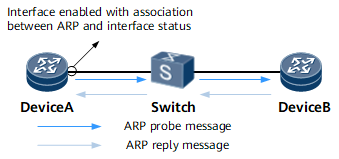Association Between ARP and Interface Status
Background
To minimize the impact of device faults on services and improve network availability, a network device must be able to quickly detect communication faults of devices that are not directly connected. Then, measures can be taken to quickly rectify the faults to ensure the normal running of services.
Association between ARP and interface status allows the local interface to send ARP probe packets to the peer interface and checks whether the peer interface can properly forward packets based on whether a reply packet is received. This triggers fast route convergence.
Related Concepts
ARP probe message
An ARP probe message sent from the local device to the peer device is an ARP request packet.
Association between ARP and interface status
The local device sends ARP probe messages to the peer device and checks whether an ARP reply message is received from the peer device. The local device then determines the protocol status by checking whether the peer device is able to properly forward packets.
Working mode
Strict mode
In strict mode, an interface sends ARP probe messages when the physical status is Up.
The protocol status of the local interface remains unchanged only when the local interface receives an ARP reply packet from the peer interface and the source IP address of the ARP reply packet is the same as the destination IP address of the ARP probe packet. If no ARP reply packet is received from the peer interface within the allowable attempts, the protocol status of the local interface is set to Down.
Loose mode
In loose mode, an interface sends ARP probe messages only when both the physical status and protocol status are Up.
The protocol status of the local interface remains unchanged only when the local interface receives an ARP packet from the peer interface and the source IP address of the ARP packet is the same as the destination IP address of the ARP probe packet. If no ARP packet is received from the peer interface within the allowable attempts, the protocol status of the local interface is set to Down.

If association between ARP and interface status is configured on devices at both ends, you are advised to configure at lease the device at one side to work in strict mode. Do not configure devices at both ends to send ARP probe messages in loose mode.
Implementation
As shown in Figure 1, association between ARP and interface status is deployed on DeviceA.
When DeviceA works in strict or loose mode (the physical status of the local interface is Up):
- DeviceA sends ARP probe messages to DeviceB.
- Within the allowable times of probes:
- If DeviceA receives ARP reply messages from DeviceB, the protocol status of the interface on DeviceA remains unchanged.
- If DeviceA does not receive ARP reply messages from DeviceB, the protocol status of the interface on DeviceA is set to Down.
Usage Scenario
Association between ARP and interface status is used when a communication fault occurs between network devices that are not directly connected.
Benefits
If association between ARP and interface status is deployed, fast route convergence is triggered upon a link fault so that the normal running of services can be ensured.
